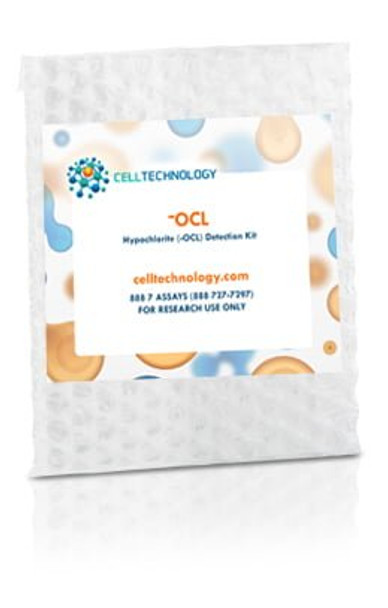Description
Hypochlorite Detection Kit | FLOCL100-2 | Cell Technology
Description
Introduction
The two new novel probes, Aminophenyl fluorescein (APF) and Hydroxyphenyl fluorescein (HPF) developed by Tetsuo Nagano et. al. (1), are selective for the detection of highly reactive oxygen species (hROS). Both probes have little reactivity towards other ROS such as: singlet oxygen (021), superoxide (O2-•), hydrogen peroxide (H202), nitric oxide (NO•), and alkyl peroxide (RO2•) (see table below)1. HPF/APF are cell permeable and can be used in combination to detect hypochlorite (-OCl) production in cells (see fig 1). Hypochlorite can be detected by loading two samples, one with APF and the other with HPF. Hypochlorite production is visualized by increase in fluorescence of APF loaded cells and no increase in fluorescence in HPF loaded cells.
Key Benefits
- Quenched Cell permeable dye.
- One Step, No wash Homogenous assay.
- Adaptable to High throughput assay platforms.
- Can monitor multiple time points to follow real time kinetics.
- Non-destructive cell based assay allows monitoring of additional parameters.
- Applications – Fluorescent plate reader / Flow Cytometery / Fluorescent Microscopy.
Additional information
Kit Size: 100
ASSAY PRINCIPLE
Figure : Detection of Hypochlorite ( -OCl ) in neutrophils. Neutrophils were isolated from porcine blood, washed in Krebs-Ringers phosphate buffer (as described in step V 1. above) and seeded in glass bottom dishes. The cells were then loaded with APF or HPF (10mM final) by incubation for 30 minutes at room temperature.
The Dye-loaded neutrophils were stimulated with PMA (2ng/mL). Fluorescence images were acquired before and 10 minutes after stimulation. Excitation: 488nm emission: 505-550 nm barrier filters1. Hypochlorite production can be detected with increase APF fluorescence and no increase in HPF fluorescence.












